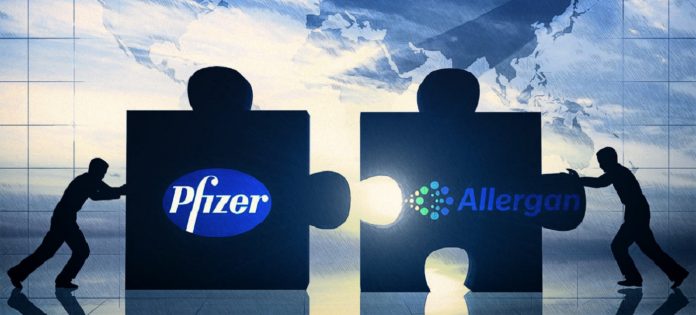This article is written by Anika Jhaveri, pursuing a Diploma in M&A, Institutional Finance, and Investment Laws (PE and VC transactions) from LawSikho.com.
Table of Contents
Introduction
The year 2016, the merger and acquisition world would be known for the deals that did not happen than those that really happened. As in April 2016, the U.S. pharmaceutical-juggernaut, Pfizer, and Irish pharmaceutical company Allergan cancelled both their $160 billion planned mergers as well as the relocation of Pfizer to Ireland, which was then reported as the largest pharmaceutical merger in dollar value. But due to the change in the tax regulations of the United States, the companies could not continue with their deal with their terms and conditions. In this article, the author talks about the structure of the deal between Pfizer and Allergan, the problem with the deal as well as the reason why the deal was cancelled.
About Pfizer
Pfizer Company is a leading global pharmaceutical company for over more than 150 years, having its headquarter in the United States. The product portfolio of the company covers medicines and vaccines as well as many consumer health products. Pfizer is organized into nine main operating divisions: Primary Care, Specialty Care, Oncology, Established Products, Oncology, Emerging Markets, Consumer Health, Animal Health, Nutrition, and Capsugel. From the penicillin miracle to Pfizer RxPathways, which helps people without prescription coverage access important medications, the company is catering to people’s diverse health needs.
About Allergan
Having headquartered in Dublin, the Allergan company is a leader in a new model of industry as it focuses on developing innovative branded pharmacies, generic and over-the-counter generic medicines, and biological products for central nervous system treatments, eye care, aesthetics medical, gastroenterology, urology, women’s health, cardiovascular as well as anti-infective therapeutic categories. The company experienced an unconventional rise, starting with a company called Watson Pharmaceuticals. In the year 2012, Watson acquired Actavis Group then bought Warner Chilcott and Forest Laboratories. It then bought Allergan, taking the name of the company. Allergan currently operates the third-largest generics company in the world, providing patients around the world with access to affordable, high-quality medicines, with business operations in more than 100 countries around the world. 
Structure of the deal
To know more about the failure of the deal it is important to how it proceeded. The structure of the deal between Pfizer and Allergan were as follows:-
The deal was completed in a stock market transaction valued at $ 363.63 per Allergan share, for a total company value of $ 160 billion, based on the closing price of the common stock of Pfizer of $ 32.18 on November 20, 2015. The transaction represented a more than 30% premium based on the unaffected share prices of Pfizer and Allergan as of October 28, 2015. Allergan shareholders will receive 11.3 shares of the combined company for each of their Allergan shares, and Pfizer shareholders will receive one share of the combined company for each of their Pfizer shares.
The completion of the transaction is subject to certain conditions, in particular
– obtaining regulatory approval in the United States and the European Union,
– the receipt of the necessary approvals from the shareholders of Pfizer and Allergan, and the finalization of the ongoing sale by Allergan of its generics business to Teva Pharmaceuticals Ltd, which is expected to be finalized by Allergan in the first quarter of 2016. Under the terms and conditions of the merger, parent company Allergan will be the parent company of the combined group,
– a wholly-owned subsidiary of Allergan will be merged with and into Pfizer, and subject to receipt of shareholder approval, Allergan’s parent company will be renamed Pfizer plc following the closing of the transaction. Allergan shareholders will own approximately 44% of the merger company.
Immediately prior to the merger, Allergan will divide its share for 11.3 for one share therefore each Allergan shareholder will receive 11.3 shares of the combined company for each of their allergenic shares, as well as the Pfizer shareholders will receive one share of the combined company for each of their Pfizer shares. US shareholders of Pfizer will recognize a taxable gain, but not a loss, for US federal income tax purposes. The transaction is expected to be tax-exempt for US federal income tax purposes for Allergan shareholders.
Change in the tax regulations : the problem of the deal
From the start of the deal, The Pfizer company and Allergan company merged because the companies wanted to save taxes. But The US government has grown increasingly skeptical of these deals as large US corporations move overseas of their headquarters in an attempt to ease taxes. Companies argue that such a strategy is necessary to be competitive in the global market. They claim that corporate taxation in the United States places American corporations at a major disadvantage. This tax has a higher corporate tax rate than in many other jurisdictions around the world and results in a strong deterrent from making profits in the United States.
The difficulty for the companies is that the companies are not able to simply move their headquarters abroad and thus meet their American tax liability. It would be a violation of the American tax code. As a result, companies looked for alternative structures that would allow a strategy of shifting their tax jurisdiction to a more favorable location: one of such locations is Ireland. Other locations include the Caribbean, various small European islands, and in some cases Canada. The types of M&A transactions, which result in a change in tax jurisdiction, have been called “corporate inversions”. They require that the two merging companies meet certain basic criteria.
- The first is that they must be of relatively comparable size.
- The second is that the resulting entity must be able to re-integrate into the jurisdiction of one of the parties. In this case, the intention would be to re-integrate the combined entity in Ireland.
As in the year 2016, President Obama and his government were well aware of the rise of corporate inversions in the country. The Obama administration has sought to reduce the impact of corporate inversions. The Treasury Department argued that such inversions violate the fundamental principles of fairness set out in the tax code. In addition, there is a huge potential reduction in revenue for the treasury. If American companies are able to merge as well as reconstitute overseas, it would then result in a serious erosion of the corporate tax base.
For governing the corporate inversions, in March 2016, the Treasury Department of the US introduced new regulations. It consists of the limitation on the number of times any company can participate in a corporate inversion. The rules further stated that any merger and acquisition transaction performed by a partner of the company in the inversion should be deducted from the value of the company.
End of the deal
After the new regulations to govern corporate inversions passed by the US government, it was difficult for both the companies to continue the deal at that time. With the new rules stating that any merger and acquisition transaction by a partner in the inversion should be deducted from the value of the company, in the three years leading up to the proposed inversion with Pfizer, Allergan was involved in two other notable inversions. In the year 2015, Allergan was involved in a $25 billion takeover of Forest Laboratories, while later in the year it was involved in a merger with Actavis in a $66 billion deal. By removing these valuations from the proposed inversion with Pfizer, Allergan has retained a net worth of around $30 billion. This has significantly reduced its size from the valuation of $200 billion attributed to Pfizer. The implication would be that Allergan would be a small shareholder of the combined entity. In fact, Allergan’s shareholders would hold only 10 to 15% of the capital of the new combined entity. The remaining value would accrue to Pfizer shareholders.
As Pfizer shareholders would control more than 85% of the capital in the merger, the company could not be reincorporated in Ireland. Consequently, the corporate inversion would no longer apply as well as the tax benefits would be eliminated. The agreement no longer made sense. Eventually, the case was dropped due to unsupportive tax regulations. Due to the termination of the merger agreement, Pfizer has agreed to pay Allergan $150 million for reimbursement of expenses associated with the transaction.
Conclusion
Though the pharmaceutical industry is still in steady growth and experiences thousands of mergers and acquisitions deals per year across the world, the proposed merger of the two biopharmaceutical corporations, Pfizer and Allergan, stood out when it was first announced on 23rd November 2015. The scrapping of the $160 billion pharmaceuticals deal, which would have been the biggest tax inversion ruse in history and also the third-largest M&A deal which could not happen, came after new US Treasury Rules designed to prevent US companies from moving abroad to reduce their tax bill. A tax deduction was the main reason for the merger: it would have allowed Pfizer to settle in Ireland, where Allergan is domiciled.
References
- https://mnacritique.mergersindia.com/pfizer-allergan-merger/#:~:text=Barely%20after%20a%20month%20of,Allergan%20plc%20for%20%24160%20billion.&text=The%20merger%20will%20broaden%20the,late%20stage%20programs%20in%20development.
- https://www.ncbi.nlm.nih.gov/pmc/articles/PMC5395057/
Students of LawSikho courses regularly produce writing assignments and work on practical exercises as a part of their coursework and develop themselves in real-life practical skills.
LawSikho has created a telegram group for exchanging legal knowledge, referrals, and various opportunities. You can click on this link and join:
 Serato DJ Crack 2025Serato DJ PRO Crack
Serato DJ Crack 2025Serato DJ PRO Crack










 Allow notifications
Allow notifications


